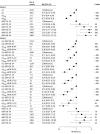Association of Albuminuria and Regression of Chronic Kidney Disease in Adults With Newly Diagnosed Moderate to Severe Chronic Kidney Disease
- PMID: 35943741
- PMCID: PMC9364131
- DOI: 10.1001/jamanetworkopen.2022.25821
Association of Albuminuria and Regression of Chronic Kidney Disease in Adults With Newly Diagnosed Moderate to Severe Chronic Kidney Disease
Abstract
Importance: People with chronic kidney disease (CKD) are risk-stratified for adverse events based on estimated glomerular filtration rate (eGFR) and albuminuria level. CKD has often a favorable course (CKD regression) regardless of eGFR. Determining whether lower albuminuria is associated with CKD regression may have implications on CKD management.
Objective: To assess the 5-year probability of CKD regression across albuminuria categories accounting for the competing risks of CKD progression and death in people with newly diagnosed CKD and the association between albuminuria level and CKD regression.
Design, setting, and participants: This population-based cohort study used administrative and laboratory data from Alberta, Canada, for adults with incident moderate to severe CKD (defined as sustained eGFR of 15-44 mL/min/1.73 m2 for >90 days), between April 1, 2008, and March 31, 2017, and albuminuria measures before cohort entry. Data analysis occurred in January to June 2022.
Exposure: Albuminuria categories were defined by albumin to creatinine ratios (ACRs): A1 (ACR, <3 mg/mmol), A2 (ACR, 3-29 mg/mmol), A3<60 (ACR, 30-59 mg/mmol), and A3≥60 (ACR, ≥60 mg/mmol).
Main outcomes and measures: The main outcome was time to the earliest of CKD regression or progression (sustained change in CKD stage for >3 months and ≥25% increase or decrease in eGFR from baseline or kidney failure, respectively), death, or censoring (outmigration or study end date: March 31, 2019). Cumulative incidence functions were used to estimate absolute risks, and cause-specific Cox models were used to assess the association between albuminuria and CKD regression, accounting for age, sex, eGFR, comorbidities, and health services use indicators.
Results: Of 58 004 people with moderate to severe CKD (mean [SD] age, 77 [12] years; 31 725 [55%] women), 35 360 had A1 albuminuria (61%), 15 597 had A2 albuminuria (27%), 1527 had A3<60 albuminuria (3%), and 5520 had A3≥60 albuminuria (10%). Five-year probability of regression was highest with A1 (22.6%), followed by A2 (16.5%), and A3<60 (11.6%) and lowest with A3≥60 (5.3%). Using A1 albuminuria as the reference group, the hazard of regression was highest for A2 (hazard ratio [HR], 0.75; 95% CI, 0.72-0.79), then A3<60 (HR, 0.47; 95% CI, 0.40-0.54), and lowest for A3≥60 (HR, 0.27; 95% CI, 0.24-0.30).
Conclusions and relevance: In this cohort study of people with moderate to severe CKD, albuminuria levels were inversely associated with CKD regression. These findings extend the key prognostic role of albuminuria, offering novel opportunities to discuss both favorable and adverse outcomes in people with CKD and inform CKD management.
Conflict of interest statement
Figures




References
Publication types
MeSH terms
Grants and funding
LinkOut - more resources
Full Text Sources
Medical
Research Materials
Miscellaneous

